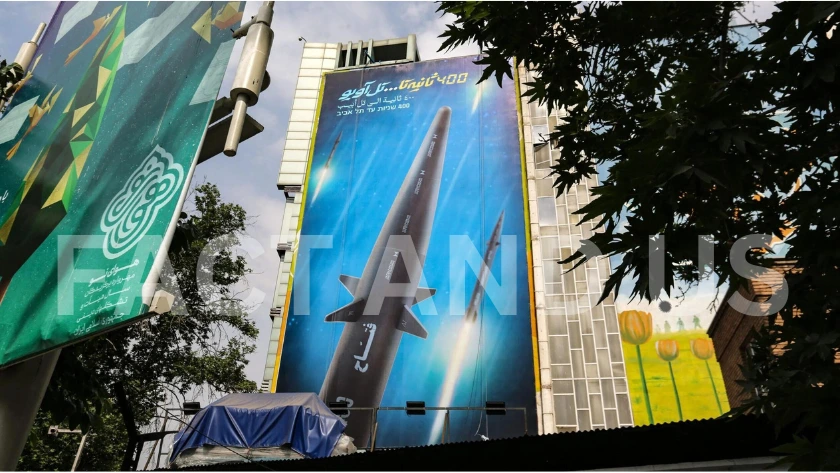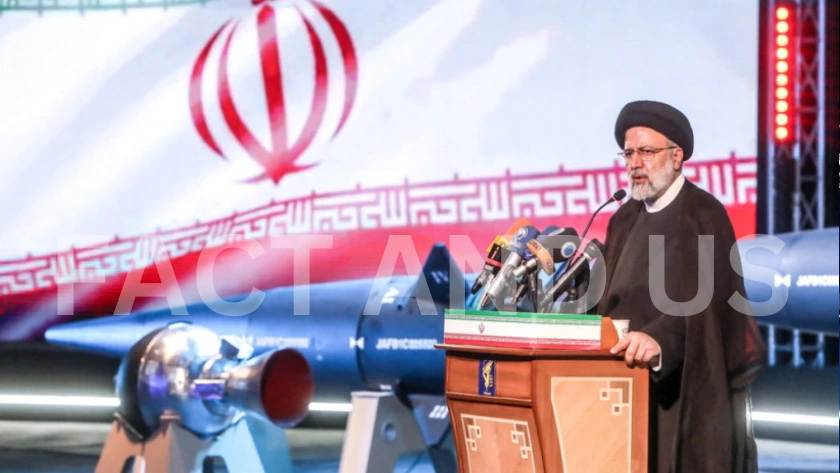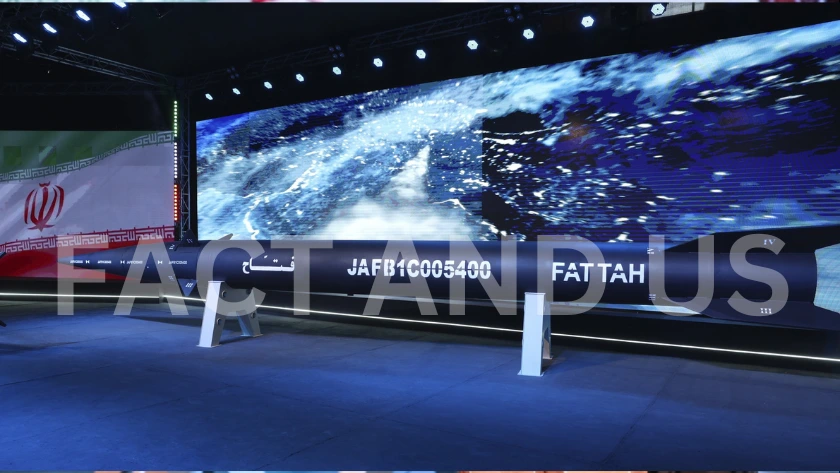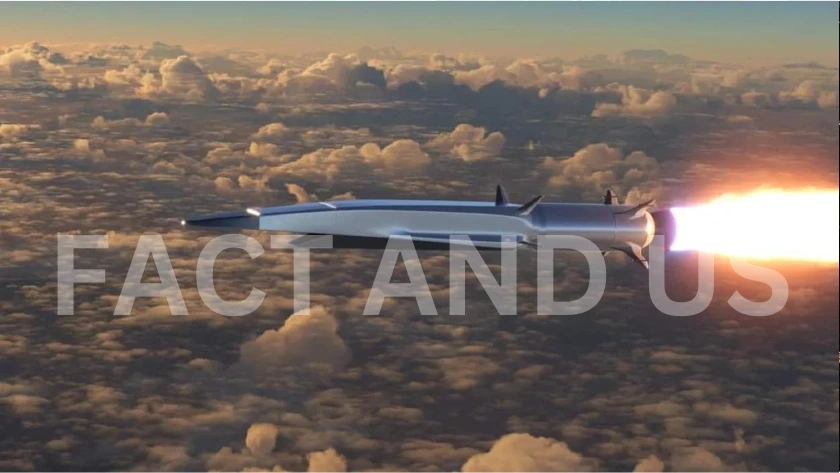It was the day of 13 April 2024 when for the first time, a picture emerged which will probably be remembered by the world for a long time, in the darkness of the night and the light of the Iranian ballistic missile in the background of the golden dome of Al-Aqsa Mosque.

That missile and drone attack by Iran managed to escape to a great extent from Israel’s famous defense system which is called Iron Dome. Ballistic missiles and drones fired from Iran fell on various places in the country including an Israeli airstrip.
Contents
- 1 Iran build a hypersonic missile
- 2 Development journey of Iranian missile program despite sanctions
- 3 Zero Point: Reverse Engineering
- 4 Underground city of missiles
- 5 Every type of missile is made in Iran
- 6 Iranian missiles can be divided into four parts-
- 7 Imad missile is an improved version of ‘Al Qadr’ ballistic missile.
- 8 Al Fatah speed: 5 kilometers per second
- 9 There is a generation of cruise missiles.
- 10 Iran’s missile operation on the border
- 11 Why did Iran increase the firepower of its missiles?
Iran build a hypersonic missile
About six months later, on the night of October 1, 2024, that attack was repeated once again and this time the Iranian Revolutionary Guards fired a larger number of missiles than before and more Israeli targets were targeted than before.
William Alberc, a researcher at the Stimson Institute and former director of NATO’s Arms Control Program, says that Iran’s recent attack has changed the situation in the Middle East forever.
Keep in mind that the Iranian missile program that made this attack possible has been progressing at an astonishing pace for several decades and the Iranian government has confidence in this program to such an extent that the ability of these missiles to hit targets is Since then the word ‘pointer’ is used for them.
That is why this missile program is creating a serious problem for the Western world and Israel as well as some Arab countries of the Middle East.
What is this missile program, what type and range of missiles does Iran have and how did the Iranian missile program become so modern despite all kinds of sanctions? Let us know the answers to these questions.
Development journey of Iranian missile program despite sanctions


According to the American organization ‘Peace Institute’, Iran has the largest and most diverse stockpile of ballistic missiles in the Middle East. At the same time, Iran is the only country in the region which does not have nuclear weapons but its ballistic missiles can reach a distance of 2000 kilometers.
Ballistic technology was ready at the time of the Second World War, but only a few countries in the world have the capability to make ballistic missiles themselves with the help of this technology.
Iran acquired this technology and also developed ballistic missiles despite strict international sanctions during the last two decades. Iran’s Supreme Leader Ali Khamenei recently said in an address that the military and missile programs that are troubling the West were prepared during the sanctions.
In 2006, the United Nations Security Council passed a resolution under which the sale of any kind of nuclear weapons or material to Iran was banned. This also included items that could be used for any other purpose as well as for military purposes.
Just three months later, the United Nations Security Council, in another resolution, imposed a complete ban on the transaction of conventional weapons from Iran, which also included military technology. Along with Iran’s nuclear program, ballistic missile program also came under the scope of sanctions imposed under this proposal.
In such a situation, it was not easy for Iran to buy weapons even from countries like Russia and China from which it was buying goods since the time of Iraq War.
Ballistic missiles are capable of carrying nuclear warheads and according to Western countries, since Iran has acquired ballistic technology, it will spare no effort to acquire nuclear energy and enrich uranium to the extent necessary to make nuclear weapons.
In July 2015, after the conclusion of the Joint Comprehensive Plan of Action agreement between Iran and six world powers and the approval of ‘Resolution 2231’, all UN Security Council sanctions against Iran were removed.
But a clause known as the ‘trigger/snap back mechanism’ kept the arms embargo in place, specifically monitoring Iran’s missile program for five years. This was a way to put pressure on Iran and control its missile program.
But Iran expanded its missile program to such an extent that in March 2016, the US, Britain, France and Germany wrote a joint letter to the Secretary General of the United Nations, accusing Iran of conducting missile tests and saying that it had violated the ‘JCPOA’ agreement. After violating the Security Council’s ‘Resolution 2231’.

Finally, in 2020, former US President Donald Trump decided to withdraw from this agreement. One reason for America’s withdrawal from this agreement was the lack of necessary procedures to deal with the threat of Iran’s missile program and to inspect this program.
Although Iran tried to show that it is part of the Joint Comprehensive Plan of Action, but with the end of the deadline in ‘Resolution 2231’, the Iranian government advertised for the purchase of weapons from Russia and China in October 2021. The sanctions are still continuing and Iran’s wish has not been fulfilled.
Since then, Iran produces more than 50 types of rockets, ballistic and cruise missiles as well as military drones, some of which have been used in international conflicts such as the war between Russia and Ukraine.
Zero Point: Reverse Engineering
During the Iran-Iraq war, the range of Iranian artillery was 35 kilometers, while the Iraqi army had ‘Scud B’ ballistic missiles with a range of 300 kilometers, which targeted many cities inside Iran.

When the Iraqi army gained advantage due to the missile attack, Iran also thought of using missiles and at that time Iran’s supreme leader Ruhollah Khomeini gave permission to counter Iran’s missile attack.
In this connection, ‘Revolutionary Guards Missile Command’ was started in November 1984 under the leadership of Hassan Tehrani Muqaddam.
Iran purchased Russian-made ‘Scud B’ missiles from Libya for the first time in 1985 and along with the consignment of 30 missiles, advisers from Libya also came to Iran for technical help and Iran’s missile operation was completed only with their help.
At that time, Amir Ali Hajizada, commander of the Revolutionary Guards’ Aerospace Force, became the head of missile unit construction and the first base for missile activities was prepared in Kirman, a city located in the west of Iran.
The first missile attack by Iran on Iraq took place on March 21, 1985, in which the city of Kirkuk was targeted. Two days later, a second Iranian attack was carried out on the Iraqi Army Officers Club in Baghdad, killing approximately 200 Iraqi commanders.
After these missile attacks by Iran, Arab countries protested against Libya, after which Libyan advisors left Iran and deactivated the missile and launching system before leaving.
In this situation, a group of members of the Iranian Air Force themselves started testing these missiles. A small group of IRGC started reverse engineering the rockets and launchers by disassembling their parts.
Hassan Tehrani Muqaddam, known as the father of the Iranian missile program, tells in the documentary film ‘Zero to One Hundred Missile Program’ that after the departure of Libyan advisors from Iran, 13 members of the Revolutionary Guards were assigned to work on the Scud ballistic missile. He was sent to Syria for training and within a limited time he understood the working of the Scud missile.
In 1986, Muqaddam was made the missile commander of the Iranian Air Force and then from 1988 onwards, the Iranian Revolutionary Guards Corps started seriously trying to develop missiles.
William Alberc, a researcher on world security and related technologies at the Stimson Institute and former director of NATO’s arms control program, told BBC Persian that over the years, China and
North Korea also cooperated with Iran on a large scale for missiles. Later Iran got Russia’s support to expand its missile program.


He also says, “It cannot be ignored that Iran is a very developed country in terms of technology and it has done a lot of research to learn how to take apart those missile parts and reassemble them by reverse engineering.” .”
In the 1990s, North Korea and later China came forward to help Iran’s missile program. The result was that some world powers tried to make China a member of the ‘Missile Technology Control Regime’ which is an informal political agreement among 35 member countries to limit the production, development and technology of missiles. China did not agree to be a part of this agreement but it definitely resolved to follow the terms of the agreement.
The ‘Nazeat’ and ‘Mujtama’ rockets were the first generation of rockets made in Iran and were soon followed by the ‘Thunder 69’ missile, which is actually a Chinese B610 short-range ballistic missile which has been redesigned by the Iranian armed forces. Designed and put into use.
Iran’s missile program was developed in the early 2000s under the supervision of Hassan Tehrani Muqaddam in the Aerospace Missile Unit of the Revolutionary Guards and with the help of Ahmed Kazmi, then commander of the IRGC Air Force. Its objective was to achieve success in the development of more modern technologies such as ballistic and satellite engines.
The second and serious phase of Iran’s missile program began with the preparation of the ‘Fatah 110’ missile.
Hassan Muqaddam was the most important figure in the development of Iran’s missile program. In 2009, he tested the ‘Extra Heavy Satellite Engine’ series for the first time during a program.
According to the Iranian statement, Hassan Muqaddam was killed along with 16 others in a blast on 12 November 2011. Many people are of the opinion that the blast at the military base was the result of a conspiracy and Hassan Tehrani Muqaddam was killed as part of a special conspiracy.
According to Iran, Hassan Muqaddam was preparing for a new missile test when two blasts occurred and he was killed in the second blast. The real reason for the blast could never be determined, but it was Hassan Muqaddam on whose grave it was written that the person who wanted to destroy Israel was buried here.
At present, the Aerospace Force of the Revolutionary Guards under the leadership of Amir Ali Hajizada is the largest organization producing missiles and drones for the Iranian armed forces. In fact, it has been responsible for Iran’s actions abroad over the past several years, rather than the Iranian military.
Underground city of missiles

Iran always showcases its missiles and presents them as a major breakthrough in military weapons development, but its missile program and development of missile bases have been secret.
The Revolutionary Guards claim that they have several missile bases built with special engineering and drilling in the form of tunnels in the mountains.
For the first time in 2014, IRGC Air Force Commander Amir Ali Hajizada talked about missile bases that have been built at a depth of up to 500 meters below the ground in different provinces of Iran.
There is no reliable information available about when these underground missile bases were built. Mehdi Bakhtiari, correspondent of the military department of the Iranian news agency, while giving an interview to Al Jazeera, said that the first underground missile base in western Iran was built in 1984 and at the same time Iran’s missile program was started.
Iranian media and Revolutionary Guards have so far released photographs of several underground missile bases which they call ‘missile cities’. The exact location of these missile bases is not known nor is any information given about it by the government.
According to published photographs of these secret underground bases, one of them, which appears to be larger than the other bases, houses the most important missile and drone weapons of the Revolutionary Guards.
One of the videos released shows a corridor filled with missiles and their launchers, as well as the area where the missiles stand ready to be fired.
In March 2019, the Revolutionary Guards Corps made public a ‘maritime missile city’ on the Persian Gulf coast. The actual location of this base was not disclosed as before, but the local media of Harmuzgan province reported about this base.
Commander in Chief of the Iranian Revolutionary Guards, Hossein Salami, had said about this ‘Merion Missile City’ located on the shores of the Persian Gulf that this complex is one of the centers of the Iranian Revolutionary Guards Navy where it stores strategic missiles. Does.
The exact number of Iran’s underground missile bases is not known, but Iran’s Army Commander Ahmad Reza Pordistan announced in January 2014 that the underground missile cities are not just for the Revolutionary Guards and the Iranian Army also owns many of them.
Amir Ali Hajizada, on behalf of the IRGC, has also announced the presence of three underground missile manufacturing factories in Iran.
Every type of missile is made in Iran

Iran’s armed forces, particularly the Revolutionary Guards’ Aerospace Forces, produce a wide range of rocket, cruise and ballistic missiles.
Ballistic missile is the most important among the missiles manufactured in Iran. The ballistic missile flies at high altitude and in an ‘arc’. There are three stages of its firing. In the second stage its speed increases to about 24 thousand kilometers per hour.
Cruise missiles are fully guided and have the ability to fly at low altitude, due to which they provide the ability to counter radar. The speed of the cruise missile starts from 800 kilometers per hour.
Iranian missiles can be divided into four parts-
.rocket
.cruise missile
.ballistic missile
.hypersonic missile
These four groups of Iran-made missiles basically include surface-to-surface and surface-to-sea missiles.
However, missiles of the defense system are also included in Iran’s weapons, some of which are made by Russia and China and some are made by the Iranian armed forces’ own efforts, which are not mentioned here.
In its missile attack on Israel in April 2024, Iran used ‘Imad 3’ ballistic missile, ‘Pawah’ cruise missile and ‘Shahid 136’ drone.
But Iran’s government news agency had also claimed to have fired ‘Khyber Shikan’ ballistic missile.
Imad ballistic missile is a medium range weapon and its range is claimed to be up to 1700 kilometers. The length of this missile is 15 meters and it is said that the weight of its warhead is 750 kg. This missile was made public in 2015.
Imad missile is an improved version of ‘Al Qadr’ ballistic missile.
‘Pawah’ is a series of medium-range cruise missiles with a range of 1650 kilometers and is said to be a generation of missiles that can take different paths to reach the target.
The ‘Pawah’ missile has the ability to attack in groups and communicate with each other during the attack and perhaps that is why it was chosen for the attack on Israel.
The ‘Pawah’ missile was made public in February 2023 and Iran claimed that this missile has the capability to reach Israel. This claim was proved true in the attack on 13 April.
Iran currently has a maximum effective range of missiles between two thousand and two and a half thousand kilometers and currently does not have the capability to target European countries.
Iran’s armed forces have claimed that this is on the instructions of Supreme Leader Ali Khamenei who had said that at present the range of Iranian missiles should not exceed two thousand kilometers. After this instruction, the process of preparation of long range missile has been stopped. According to Ayatollah Khamenei, there is a ‘reason’ for this decision but he did not give that reason.
‘Zulfiqar’ is another short-range (700 km) ballistic missile which was used to attack Daesh (ISIS) targets in 2017 and 2018. This missile is 10 meters long, has a mobile launch platform and is claimed to be equipped with the ability to remain invisible to radar.
‘Zulfiqar’ is an improved version of the Fateh 110 missile and its warhead is said to weigh 450 kg.
International security expert William Alberk told the BBC that Iran has a very good missile production capability and that Iran’s missile program has developed by borrowing and copying missiles from other countries.
“They are moving from liquid fuel to solid fuel rockets and missiles. The missile’s ability to accurately engage targets has increased dramatically. Iran has made a lot of progress in this matter. “At present, its program is one of the most advanced missile programs for short and medium range ballistic and cruise missiles.”
Al Fatah speed: 5 kilometers per second

William Alberc, referring to the military cooperation between Iran and Russia in recent years, said that this cooperation will give Iran the opportunity to learn from the Russians and get more modern missile designs, technology and capabilities.
Iran has claimed that its new generation of missiles is from the generation of hypersonic weapons. Hypersonic means those weapons whose speed is usually 5 to 25 times more than the speed of sound.
For the first time, Iran had introduced the Fatah missile as a hypersonic missile in both ballistic and cruise categories.
Al-Fatah’s hypersonic missile has a range of 1400 kilometers and the IRGC has claimed that it has the ability to destroy all missile defense systems by dodging them.
‘Al-Fattah’ is a generation of solid fuel missile which has a speed of 13 to 15 ‘Mach’ before hitting the target. Mach 15 means a speed of five kilometers per second.
Commander of the Revolutionary Guards Aerospace Organization, Amir Ali Hajizada, said at the unveiling ceremony of the Al-Fatah missile that this missile is high-speed and can go in and out of the atmosphere. Besides, Hajizada had also claimed that Fatah cannot be destroyed by any missile.
After the unveiling of the Al-Fatah ballistic missile, a poster was put up in Tehran’s Palestine Square to threaten Israel with the words ‘Tel Aviv in 400 seconds’ written on it.
Israeli Defense Minister Yoav Galant said in response to Iran’s claims and threat of making hypersonic missiles, “I have heard that our enemies are boasting about the weapons they have made. “We have a better answer to any technology, whether it is on land, in the air or at sea.”
Four months after the unveiling of ‘Al-Fatah 1’, the Revolutionary Guards unveiled ‘Al-Fatah 2’ which has a range of 1500 kilometers.
There is a generation of cruise missiles.
According to Iranian media, ‘Al-Fatah 2’ has the ability to fly at very low altitude and can also change its path several times during the flight.
The ‘Al-Fattah 2’ cruise missile was unveiled when Iran’s Supreme Leader Ali Khamenei visited the IRGC-affiliated Ashura University of Aerospace Sciences and Technology, but no information was given about the range of this missile.
Although Iran had introduced Fatah missiles to deal with the threat against Israel, it did not use these missiles in the attacks on April 13 and again on October 1.
Iran’s missile operation on the border

Over the past decade, Iran has been involved in regional disputes for a variety of reasons and has carried out cross-border operations against groups, groups and countries hostile to its soil.
All of Iran’s foreign operations have been carried out by the Revolutionary Guards’ Air Force, and this department has assumed responsibility for involvement in and response to disputes instead of Iran’s military.
Keep in mind that after the end of the Iran-Iraq war, the army of ‘Quds Force’, the foreign branch of the Revolutionary Guards, was present in Afghanistan, Bosnia and Herzegovina, Iraq, Syria and Lebanon etc. but it was not considered as Iran’s government presence or response.
After the end of the Iran-Iraq war, the first attack on another country from Iranian soil took place against ‘Daesh’ in the Syrian city of Deir al-Zor. This operation, which was named ‘Lailatul Qadr’, was carried out in response to the ‘Daesh’ attack on the Islamic Council. In this, six medium-range ballistic missiles ‘Zulfikar’ and ‘Qayam’ were fired at the headquarters of ‘Daesh’ from Kirman Shah and Kurdistan.
Then the headquarters of the Kurdistan Democratic Party of Iran in Quesanjak, located in the Kurdistan region of Iraq, was targeted with seven ‘Al-Fatah 110’ missiles. In a statement, the Revolutionary Guards announced that this was revenge for the July 2017 attack on the Sayyid al-Shohada Hamza base in Mariwan.
On 9 October 2017, Iran’s Revolutionary Guards responded to the attack on the armed forces parade in Ahvaz with the help of six ‘Qayam’ and ‘Zulfiqar’ missiles and seven military drones in Syria in an operation named ‘Moharram Attack’. Destroyed the ‘Daesh’ hideout on the river bank.
On January 18, 2018, in response to the death of Quds Force commander Qasim Sulemani at the hands of the US in Iraq, the Revolutionary Guards Air Force fired thirteen ‘Fatah-313’ and ‘Qayim 2’ ballistic missiles at Ainul Asad, the largest US military base in Iraq. . Apart from this, a base in Arbil, the capital of Kurdistan region of Iraq was also attacked.
After the death of Qasim Sulemani, there was an increase in Iran’s missile attacks on neighboring countries.
In March 2022, the Revolutionary Guards Corps fired a Bar Fatah-110 ballistic missile at the house of Bazkarim Barzanji, which Iran claimed was one of Israel’s strategic centers in the Kurdistan region.
The following year, the Revolutionary Guards Air Force attacked the headquarters of Iranian Kurdish parties in Iraqi Kurdistan with ‘Fatah 360’ missiles in operations named ‘Rabi 1’ and ‘Rabi 2’.
In January 2024, the IRGC once again attacked the house of an Iraqi Kurdish businessman, which it described as the headquarters of Mossad, and also attacked the bases of ‘Daesh’ and Hizb al-Turkistani in Adlib.
On January 26, 2024, the Air Force of the Revolutionary Guard Corps attacked the center of Jaish al-Adl group in Balochistan province of Pakistan with a missile. The very next day, Pakistan fired missiles at many places in Sistan and Baluchistan province of Iran. This was the first time that a country had responded directly to Iran’s missile attack.
Following the death of Iranian General Mohammad Reza Zahidi and six other IRGC officers in an Israeli missile attack on the Iranian Council House building in Damascus, Iran attacked Israel with hundreds of drones and cruise and ballistic missiles during the operation named ‘Vahdatul Sadiq’. Did it. Iran claimed that the attack targeted airstrips in the Golan Heights.
BBC Persian’s investigation had earlier reported that the Iranian missile targeted at least two places on Navatim Air Base and caused damage.
International security researcher William Alberk told the BBC that the Iranian missile attack on Israel showed some lack of ability of Iranian missiles to hit the target and reach the target, but he is of the opinion that Iran took a lot from this attack. Learned.
He not only learned about Israel’s defense capability but also learned a lot about other countries joining forces with Israel to intercept Iranian missiles.
Why did Iran increase the firepower of its missiles?

Before the Iranian Revolution, Iran’s biggest ally was America and most of the military weapons, including fighter planes, were purchased from America.
Iran purchased 160 ‘F-5’ aircraft which were designed as cheap fighter aircraft for those countries which could not buy expensive fighter planes. During the Pahlavi regime, a large number of McDonnell Douglas F4 warplanes were also purchased for Iran, which are still included in the Air Force fleet.
Then the Shah of Iran decided to replace them with a new fighter aircraft and 60 ‘F-16’ Tom Cat planes were purchased. At that time Iran was one of the countries with the largest number of war aircraft in the Middle East.
After the Islamic Revolution, relations between Iran and America ended forever due to the attack and occupation of the embassy in Tehran. Iran was targeted by several American sanctions, including an arms embargo. Since it was not possible to purchase modern weapons and warplanes and during the war Iraq’s ballistic missiles targeted Iran from within, hence it decided to start a rocket program.
In such a situation, the missile program was the best option for Iran, which could use it as a defense weapon and in case of war, it would have access to other countries as well.
For this reason, Iran’s missile program is currently counted among the most modern and most important weapons programs of that country.
William Alberc, a researcher in international security and related technologies, says that this missile was an excellent alternative to fighter planes, which did not require much training and pilots and posed less danger to civilians because they were easier to fire.
Speaking to the BBC, he said, “Clearly Iran can produce missiles of its own and missiles are much cheaper than warplanes. In such a situation, Iran is looking for missiles for many reasons.”
This former NATO arms control expert says that this missile is a very beneficial weapon for Iran for its political and military relations with non-state actors and countries dependent on Iran.
As information about Iran’s missiles and its stockpile of weapons continues to increase,
stay connected with fact and us for more such news.
